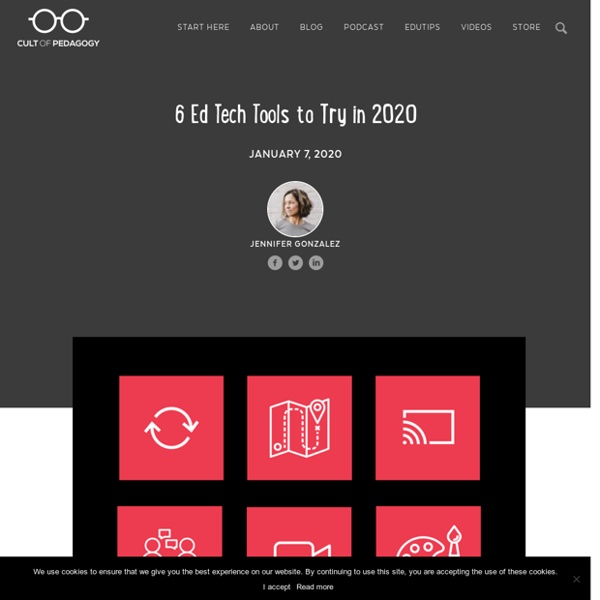



https://www.cultofpedagogy.com/6-ed-tech-tools-to-try-in-2020/
Related: Ikt2 • Altres • Summer PD 2020 • APU- MA in Educational Tech 2020-2021 Ramirez • Educational TechnologyTeaching Students to Disagree Productively On a cool October morning, energy buzzed in a third-grade classroom in western Massachusetts. Students sat on the rug, raising their hands and grinning from ear to ear. As I entered at the back of the room, I was struck to hear the words “I disagree!” coming from the carpet. Why do we need technology integration in education? Technology in education mirrors the fast-paced world we live in. In modern classrooms, it’s rare to find students all working on the same exact activity. Instead, today’s schools are technology-rich learning spaces that promote diverse activity. They’re abuzz with collaboration, critical thinking, creativity, and communication, all thanks to technology. 6 cool educational technology tools for teachers We’ve all been to professional development events that focus on educational technology — vendors are always touting the next big thing to help students learn. But which educational technology tools should you work with, and why? Whatever technology you settle on, it needs to benefit both you and your students.
Born a Crime by Trevor Noah: 9780399588198 “[An] unforgettable memoir.”—Parade “You’d be hard-pressed to find a comic’s origin story better than the one Trevor Noah serves up in Born a Crime. . . . [He] developed his aptitude for witty truth telling [and]…every hardscrabble memory of helping his mother scrape together money for food, gas, school fees, and rent, or barely surviving the temper of his stepfather, Abel, reveals the anxious wellsprings of the comedian’s ambition and success. If there is harvest in spite of blight, the saying goes, one does not credit the blight-but Noah does manage to wring brilliant comedy from it.”—O: The Oprah Magazine “What makes Born a Crime such a soul-nourishing pleasure, even with all its darker edges and perilous turns, is reading Noah recount in brisk, warmly conversational prose how he learned to negotiate his way through the bullying and ostracism. . . .
The Touchpoints of Educational Technology Excellence - The International EdTech Blog with Matt Harris Ed.D. I have had the pleasure to work with a number of schools around the world in the area of Educational Technology. Usually, if schools want to talk to me it is either to show me something amazing or to ask my advice on becoming a school that would have something amazing to show. Sadly, a large portion of international schools fall into that latter category.
Flipped Classroom: Engaging Students with EdPuzzle The flipped classroom model is a blended learning strategy I use to present my vocabulary, writing, and grammar instruction online. Students watch videos at home where they can control the pace of their learning, then they come to class prepared to apply that information in collaborative student-centered activities. One thing I emphasize when I lead professional development for teachers is the importance of flipping and engaging. Instead of simply consuming information, I want students to think critically about that information.
26 YouTube shortcuts everyone should know YouTube is a powerful resource for schools. Once you get past the cat videos there are vast amounts of educational videos for all grade levels, subject area, and educator professional development. (Be sure to visit my YouTube channel for my one-hour webinars, short tech videos, and monthly Google User Group recordings.) But in addition to just watching videos on YouTube, there are also dozens of keyboard shortcuts you can use to improve your viewing experience. These include keys to jump around in the video, change speed, adjust sound, switch the view, and more.
How to Be an Anti-racist Teacher I have seen some of these very same students walk into another teacher’s classroom, go to the last row of desks, and put their head down. I have seen them sit frozen in their seat, staring at an assignment—when earlier I had heard them make jokes, talk excitedly about the content of their history class, celebrate solving a vexing algebra equation, or shake a test tube with authority, waiting for a result. Their report cards often reveal this disparity in classroom experiences: A’s and B’s in classes where they feel valued and C’s, D’s, or even F’s in classes where they don’t. Remote Teaching in a Hurry – ION Professional eLearning Programs - University of Illinois Springfield - UIS Free Webinar on Remote Teaching Resources for Remote Teaching for Community Colleges Dr.